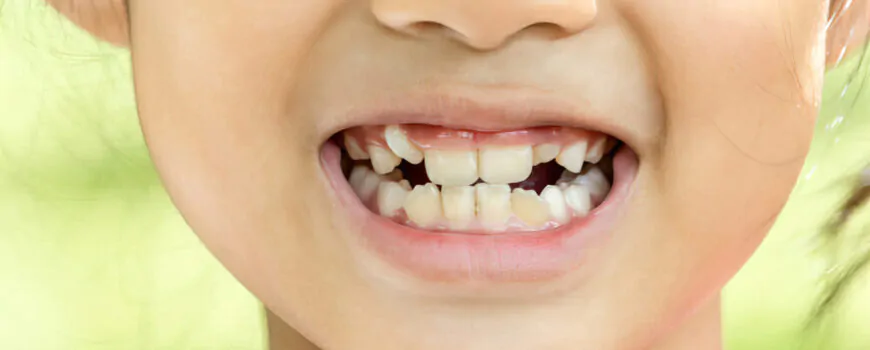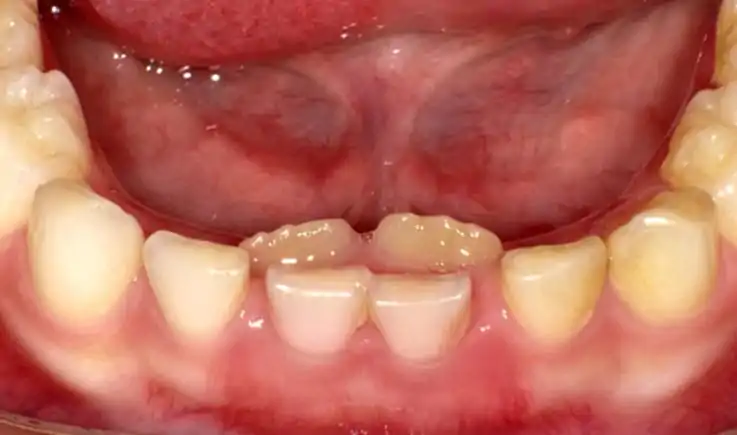
Q: Why are My Child’s New Lower Teeth Erupting Behind Her Milk Teeth?

Is this what you’re seeing in your child’ mouth? Fret not, this is actually quite common!
This is undoubtedly the most common question asked by panicked parents when they notice their 6- or 7-year-old’s permanent lower front teeth erupting behind the milk teeth. Seeing two rows of teeth (some would describe as “shark’s teeth”) triggers major concern as parents worry that their child’s well aligned baby teeth are now affected by the rogue adult teeth.

Another example of lower permanent incisors erupting behind their primary counterparts.
The truth is, this is the normal position of the permanent lower incisors – they are situated behind the milk teeth and will almost always erupt behind the milk teeth. However, they will drift forward once the milk teeth exfoliate and there is now space for them to move forward. If the milk teeth are slightly shaky, get your child to use her own fingers to shake the milk tooth every day to accelerate the exfoliation process. The milk teeth usually do not need to be extracted unless they are very firm and the adult incisors have erupted to almost the same height as the milk teeth.

_

_
Do take note this only applies to the lower front teeth. As for the upper adult incisors, they usually erupt after the milk teeth have dropped off, so this scenario is less common. So, unless the milk tooth remains solidly firm while the adjacent adult tooth erupts, do relax and let nature take its course. Parenting is not easy and hopefully you will now have one less thing to worry about!
Q: Why are my child’s adult teeth so yellow and jagged compared to his baby teeth?

Distinctly yellow permanent upper central incisors

Care to guess which ones are the permanent teeth?
Freshly erupted adult teeth tend to look more yellow and have irregular edges compared to their deciduous or milk teeth counterpart. The adult teeth’s outermost layer, which is the enamel, is actually a lot more translucent, allowing the yellower dentine layer inside to show through. The baby teeth’s enamel, on the other hand, are a lot more opaque and the teeth appear as white as milk, hence the term “milk teeth”.
The jagged bumps on the edge of the teeth, specifically the incisors, are known as mamelons. They are actually caused by the formation of the teeth, but because they are very thin and uneven, soon they will get worn down and have a flatter edge. Newly erupted baby incisors actually have mamelons too, but by the time they are side-by-side with their adult counterpart, they have already been worn down!

Tiny little mamelons on the baby’s newly-erupted incisors. You probably don’t remember this was how the baby teeth first looked like. You were probably suffering the effects of sleep deprivation then to notice.
Is there any treatment for this? We do not recommend any procedures to whiten the adult teeth or to grind down the irregular edges at the mixed dentition stage since it is purely an aesthetic problem and not really necessary. The best option is to wait it out until your child has his complete set of permanent teeth (at around 12-13 years old) before deciding if he indeed has yellow teeth in need of whitening, and preferably after a Scaling and Polishing appointment to remove the plaque and stains build-up. Sometimes all it takes is a thorough round of cleaning and your child’s teeth will look a lot whiter without all the gunk.
Q: Why Are My Child’s Adult Teeth Now So Crooked? He Had Such Straight Baby Teeth!

Worried about your child’s crooked teeth?
During the mixed dentition phase, also known rather callously as the “ugly duckling” phase, the larger adult teeth will erupt into a jaw that is still developing, and if the child has a small jaw, then there will be not enough space for all the teeth to be well aligned. Ideally, there should be some slight spacing between the milk teeth to compensate for the larger adult teeth, but if your child’s milk teeth are tightly aligned with each other (hence having what is considered a perfect smile), then naturally his adult teeth will be crooked, or more appropriately, crowded. If his milk teeth are already slightly crowded, then it is almost certain he will have a crowded permanent dentition.

Some spacing between the milk teeth is actually good!
If it is obvious that his teeth are very crooked and that is affecting his self esteem, having orthodontic treatment or braces can help to align the teeth to achieve a well-balanced smile. Usually the best time to start braces would be once he turns 12-13 years old, which is usually the time when all the milk teeth are shed and the second permanent molars are erupted.
Read more: Part 2 for Parents’ FAQ about Erupting Permanent Teeth
In the meantime, if you would like an appointment for yourself or your child, click here or on the button below:
Request an Appointment with Us
Back to top
